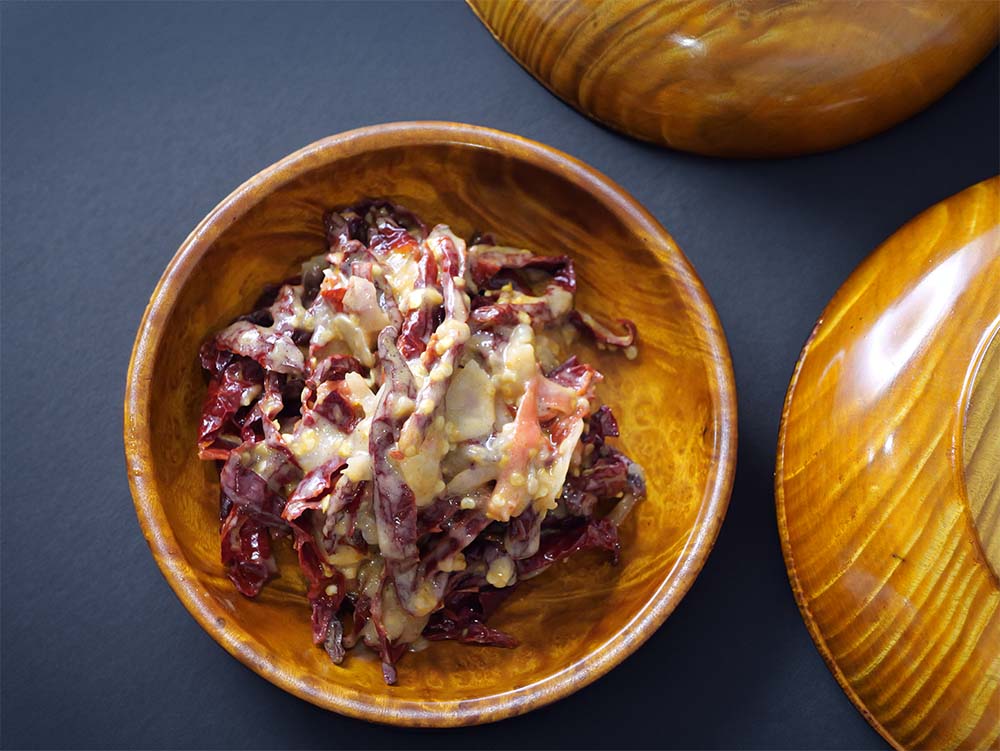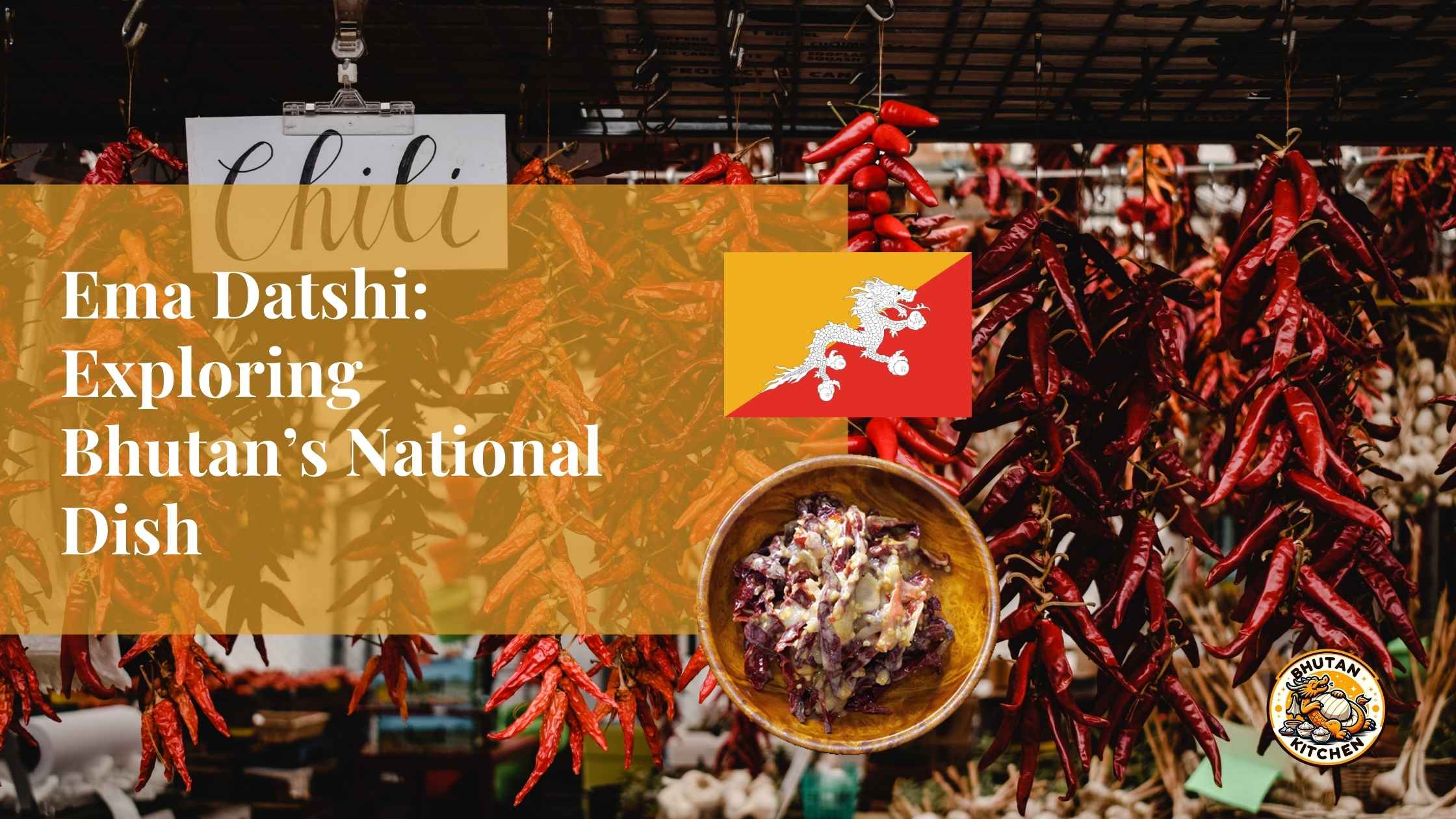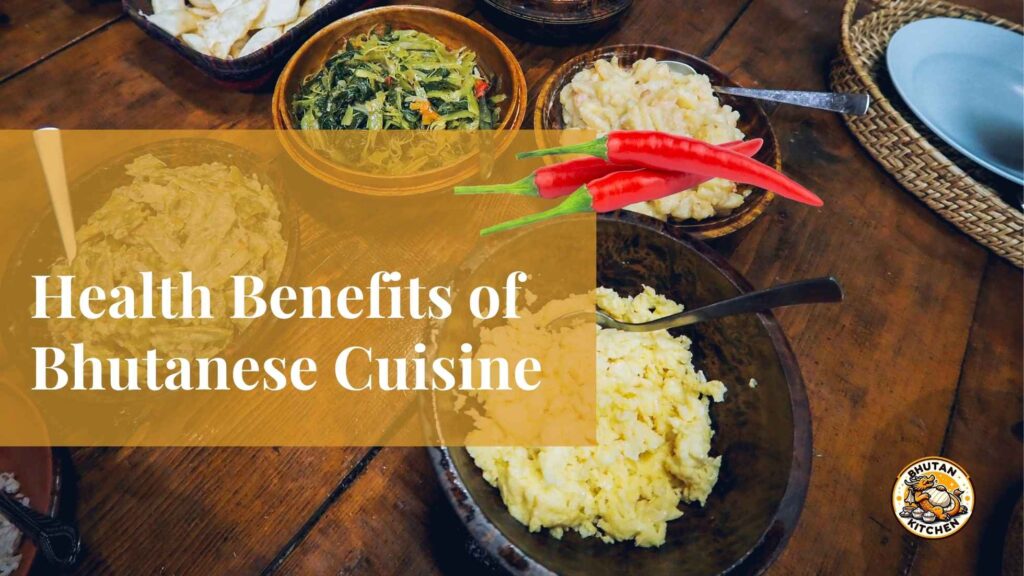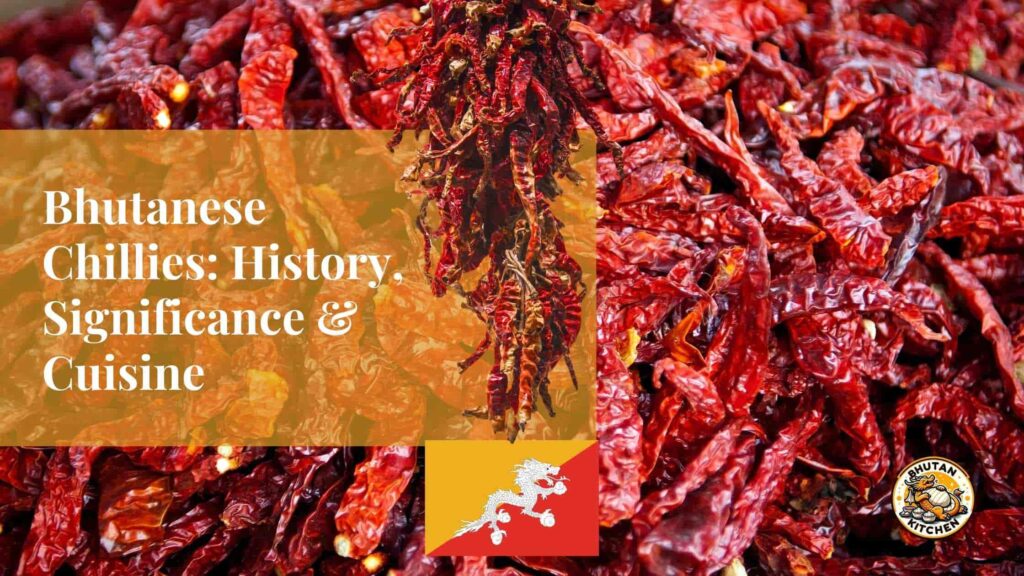Ema Datshi, often referred to as the “soul of Bhutanese cuisine,” is a dish that represents more than just food; it embodies the culture, traditions, and agricultural simplicity of Bhutan. At its core, the dish is a fiery stew made with chili peppers (ema) and Bhutanese cheese (datshi), a reflection of the Bhutanese palate’s preference for bold and spicy flavours.
What makes Ema Datshi unique is its widespread presence across Bhutan. Whether served at a humble family dinner or a grand celebratory feast, it holds a cherished place on the table. In this article, we will cover the ingredients, how to make it and why it is so important in Bhutanese cuisine.
Ingredients of Ema Datshi
Ema Datshi’s charm lies in its simplicity, built upon ingredients that are staples in Bhutanese households.
Key Ingredients:
- Chilies (Ema):
- The heart of Ema Datshi, chilies are treated as vegetables rather than mere spices in Bhutanese cuisine.
- Varieties used include fresh green chilies, red chilies, and sometimes dried white chilies (Shukam). These are known for their robust heat and earthy flavour.
- Chilies are dried outdoors and the dry cold Bhutanese air, lead to an interesting flavour. So try to source Bhutanese chillies if you can.
- Datshi (Cheese):
- A soft cheese made from cow or yak milk, datshi is integral to the dish.
- Its creamy, slightly tangy taste balances the spiciness of the chilies.
- Datshi is produced locally in Bhutan and can be eaten fresh or matured, in which case it’s called Zoety.
- Supporting Ingredients:
- Onions and Tomatoes: Add sweetness and acidity to round out the dish.
- Garlic: Provides aromatic depth.
- Butter: A touch of butter enriches the texture, enhancing its creamy consistency.
Cultural Significance:
The ingredients of Ema Datshi reflect Bhutan’s self-sustaining agricultural practices and love for fresh, local produce. Chilies, grown in terraced fields, and datshi, crafted from milk in small-scale farms, exemplify the farm-to-table philosophy intrinsic to Bhutanese culture.

How to Prepare Ema Datshi
Ema Datshi’s preparation is straightforward, making it an approachable dish for home cooks eager to explore Bhutanese cuisine. Despite its simplicity, the dish delivers a harmonious blend of spiciness and creaminess that makes it iconic.
Step-by-Step Recipe
- Ingredients (for 4 servings):
- 6-8 fresh green or red chilies (adjust based on heat preference)
- 1 cup Bhutanese datshi or a soft cheese like feta or ricotta as a substitute
- 1 medium onion, thinly sliced
- 2 medium tomatoes, chopped
- 2-3 garlic cloves, minced
- 2 tablespoons butter
- 1 cup water
- Salt to taste
- Preparation:
- Step 1: Wash and slice the chilies lengthwise. If you prefer less heat, remove some seeds.
- Step 2: Heat water in a pot over medium heat. Add the sliced chilies, onions, tomatoes, and garlic.
- Step 3: Simmer the mixture for about 10 minutes, allowing the vegetables to soften.
- Step 4: Add the butter and cheese to the pot. Stir gently to melt the cheese, creating a creamy consistency.
- Step 5: Season with salt to taste. Reduce heat and simmer for another 5 minutes to let the flavors meld.
- Serving:
- Serve hot with Bhutanese red rice or steamed white rice. The nutty flavor of the red rice pairs perfectly with the spiciness of the stew.
Cooking Tips
- Cheese Substitution: If authentic datshi is unavailable, feta cheese is a good alternative due to its creamy and slightly tangy profile.
- Chili Adjustment: For milder versions, opt for fewer chilies or use a mix of spicy and sweet peppers. Bhutanese Red Dried Chillies tend to have a more sweet profile too.
- Vegetable Enhancements: Add mushrooms or potatoes for a heartier version.
Variations of Ema Datshi
While the traditional Ema Datshi is beloved, Bhutanese households often create variations by substituting or adding ingredients to suit different tastes or available produce. These variations maintain the essence of the dish and have become stable entries into Bhutanese Cuisine.
Popular Variations:
- Kewa Datshi (Potato Datshi):
- Ingredients: Thinly sliced potatoes replace or complement the chilies.
- Flavor Profile: The potatoes provide a starchy, mild base that tempers the heat, making it a more balanced dish for those less accustomed to spice.
- Pairing: Often served with a side of leafy greens or fermented vegetables.
- Shamu Datshi (Mushroom Datshi):
- Ingredients: Fresh or dried mushrooms are used instead of chilies.
- Flavor Profile: Earthy and creamy, this version is a popular choice during the mushroom harvest season.
- Pairing: Pairs well with Bhutanese red rice and lightly spiced lentils.
- Shakam Datshi (Dried Beef Datshi):
- Ingredients: Dried beef strips (shakam) are simmered alongside chilies and cheese.
- Flavor Profile: The dried beef adds a smoky, savory depth, making it a heartier option.
- Pairing: Typically enjoyed during Bhutan’s colder months as a comforting, protein-rich dish.
- Mixed Vegetable Datshi:
- Ingredients: A medley of vegetables such as green beans, carrots, and spinach.
- Flavor Profile: A colorful and nutritious take that highlights Bhutan’s seasonal produce.
- Pairing: Suitable for vegetarian meals with rice or flatbread.
Cultural Significance of Ema Datshi
Ema Datshi is more than just a culinary delight; it is a cornerstone of Bhutanese identity, deeply intertwined with the country’s traditions, lifestyle, and agricultural practices. Its ubiquitous presence in Bhutanese cuisine reflects both cultural values and practical aspects of life in the Himalayan kingdom.
Symbol of Bhutanese Identity
- Everyday Staple: Ema Datshi is consumed daily in most Bhutanese households, transcending social and economic boundaries.
- A Unique Palate: Bhutan’s love for spicy food is embodied in Ema Datshi, where chilies are not merely a spice but a main ingredient. This sets Bhutan apart in the global culinary scene.
Connection to Agriculture
- Locally Grown Ingredients: The dish highlights Bhutan’s reliance on local farming. Chilies and dairy products are abundantly grown and produced in the country, ensuring the dish remains accessible and sustainable.
- Seasonal Variations: Ingredients used in variations of Ema Datshi often depend on seasonal availability, making it a dynamic part of Bhutanese cuisine.
Social and Ritual Significance
- Family Meals: Preparing and sharing Ema Datshi is a communal activity, fostering familial bonds and a sense of togetherness.
- Festivals and Celebrations: The dish is often featured during festivals, religious ceremonies, and special occasions, showcasing its integral role in Bhutanese culture.
Bhutan’s Philosophy of Happiness
- Gross National Happiness: Bhutan’s emphasis on Gross National Happiness extends to its culinary traditions. Ema Datshi, with its comforting flavors and reliance on sustainable ingredients, exemplifies a balance between simplicity and satisfaction.
Ema Datshi thus serves as both a daily comfort food and a cultural emblem, encapsulating the spirit of Bhutan and its harmonious way of life.
Serving and Pairing Suggestions
Ema Datshi is a versatile dish, traditionally enjoyed with accompaniments that enhance its flavors and offer a complete Bhutanese dining experience. The way it is served not only highlights its bold and spicy profile but also showcases Bhutan’s culinary harmony.
Traditional Serving
- With Bhutanese Red Rice:
- The nutty flavor and slightly sticky texture of Bhutanese red rice complement the creamy spiciness of Ema Datshi perfectly.
- Red rice, cultivated in Bhutan’s high-altitude valleys, adds a nutritional boost with its rich fiber and mineral content.
- With Side Dishes:
- Phaksha Paa: A pork dish cooked with radishes and chilies, offering a savory counterpart to Ema Datshi.
- Jaju: A mild Bhutanese soup made from spinach and milk, balancing the heat of the dish.
- Ezay (Chili Sauce): A spicy chili relish often served alongside for those who crave an extra kick.
Modern Adaptations
- As a Dip or Side:
- Serve Ema Datshi as a rich dip with bread or crackers for a contemporary twist.
- In Fusion Dishes:
- Use it as a sauce for pasta or as a topping for baked potatoes to create a Bhutanese-inspired fusion dish.
Beverage Pairings
- Traditional Pairings:
- Suja (Butter Tea): A salty, buttery tea that balances the dish’s spiciness.
- Ara: A traditional Bhutanese alcoholic beverage, often served warm, that complements the dish’s hearty flavors.
- Modern Drinks:
- Light, chilled beers or white wines with floral notes pair well with the dish’s richness.
Ema Datshi’s adaptability to both traditional and modern meals demonstrates its universal appeal. Whether enjoyed in a rural Bhutanese home or at a fine-dining restaurant, it remains a dish that connects people to the heart of Bhutan.
Global Appreciation of Ema Datshi
In recent years, Ema Datshi has gained international recognition, captivating food enthusiasts worldwide with its bold flavors and cultural significance. The dish serves as a gateway to understanding Bhutanese cuisine and traditions, bridging cultural gaps and fostering global appreciation for Bhutan’s culinary heritage.
Rising Popularity
- Tourist Favorite:
- Visitors to Bhutan are often introduced to Ema Datshi as a must-try dish, creating lasting impressions of the country’s vibrant food culture.
- Many tourists attempt to recreate Ema Datshi at home, spreading its influence beyond Bhutan’s borders.
- Showcased in Culinary Media:
- Ema Datshi has been featured in global culinary shows, food blogs, and recipe books, amplifying its status as a symbol of Bhutanese cuisine.
- Renowned chefs and food writers often highlight the dish as an example of Bhutan’s focus on simplicity and bold flavors.
Adaptations for Global Palates
- Modified Recipes:
- To accommodate milder taste preferences, international adaptations often use fewer chilies or mix them with sweet peppers.
- Substitutes like cheddar or cream cheese are sometimes used when authentic datshi is unavailable, ensuring accessibility.
- Fusion Cuisine:
- Ema Datshi-inspired dishes, such as chili and cheese flatbreads or spicy cheese soups, are emerging in global menus, blending Bhutanese flavors with contemporary culinary trends.
Cultural Exchange Through Cuisine
- The growing popularity of Ema Datshi fosters a deeper appreciation for Bhutanese traditions and sustainable practices.
- It encourages dialogue about Bhutan’s unique philosophy of Gross National Happiness, as food becomes a medium for cultural exchange.
By transcending its origins, Ema Datshi has become more than just a national dish; it is a cultural ambassador for Bhutan, inviting the world to savor the simplicity and warmth of its cuisine.
Ema Datshi, Bhutan’s national dish, is a testament to the country’s deep-rooted cultural identity and its reliance on sustainable, locally sourced ingredients. Beyond its bold flavors and creamy textures, the dish serves as a symbol of Bhutanese hospitality and the simplicity of Himalayan life.
Whether enjoyed as a daily staple in Bhutanese homes, celebrated during festivals, or adapted to global palates, Ema Datshi connects people to the heart of Bhutan’s culinary and cultural traditions. For those seeking to experience Bhutan through its cuisine, preparing or tasting Ema Datshi is an essential and flavorful journey.
The dish’s universal appeal and cultural significance make it a perfect ambassador of Bhutanese cuisine, inviting the world to embrace its bold simplicity and warmth.



